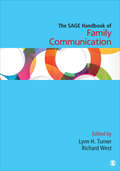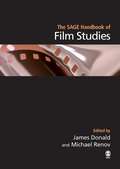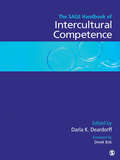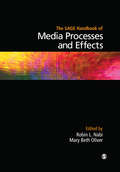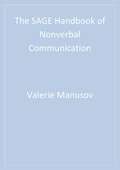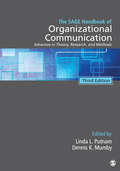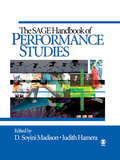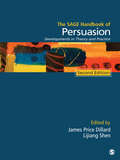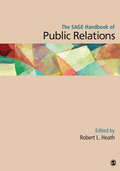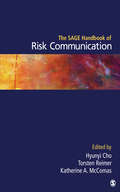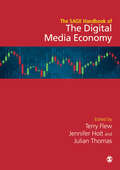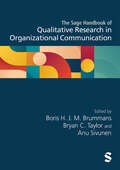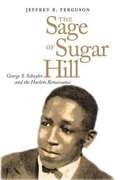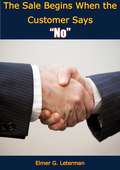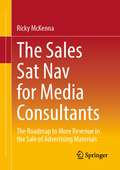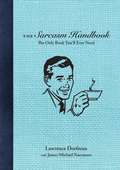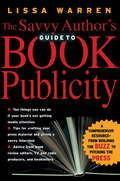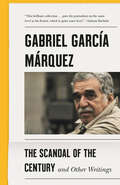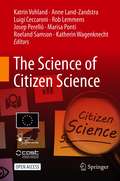- Table View
- List View
The SAGE Handbook of Family Communication
by Dr Lynn H Turner Richard L. WestA thorough exploration of the critical topics and issues facing family communication researchers today The Sage Handbook of Family Communication provides a comprehensive examination of family communication theory and research. Chapters by leading scholars in family communication expand the definition of family, address recent shifts in culture, and cover important new topics, including families in crisis, families and governmental policies, social media, and extended families. The combination of groundbreaking theories, research methods, and reviews of foundational and emerging research in family communication make this an invaluable resource that explores the critical topics and issues facing family communication researchers today.
The SAGE Handbook of Family Communication
by Dr Lynn H Turner Richard L. WestA thorough exploration of the critical topics and issues facing family communication researchers today The Sage Handbook of Family Communication provides a comprehensive examination of family communication theory and research. Chapters by leading scholars in family communication expand the definition of family, address recent shifts in culture, and cover important new topics, including families in crisis, families and governmental policies, social media, and extended families. The combination of groundbreaking theories, research methods, and reviews of foundational and emerging research in family communication make this an invaluable resource that explores the critical topics and issues facing family communication researchers today.
The SAGE Handbook of Film Studies
by Michael Renov Dr James DonaldWritten by a team of veteran scholars and exciting emerging talents, The SAGE Handbook of Film Studies maps the field internationally, drawing out regional differences in the way that systematic intellectual reflection on cinema and film has been translated into an academic discipline. It examines the conversations between Film Studies and its contributory disciplines that not only defined a new field of discourse but also modified existing scholarly traditions. It reflects on the field's dominant paradigms and debates and evaluates their continuing salience. Finally, it looks forward optimistically to the future of the medium of film, the institution of cinema and the discipline of Film Studies at a time when the very existence of film and cinema are being called into question by new technological, industrial and aesthetic developments.
The SAGE Handbook of Intercultural Competence
by Darla K. DeardorffBringing together leading experts and scholars from around the world, this Handbook provides a comprehensive overview of the latest theories and research on intercultural competence. It will be a useful and invaluable resource to administrators, faculty, researchers, and students.
The SAGE Handbook of Interpersonal Communication
by John A. Daly Professor Mark L. KnappThe revised Fourth Edition of The SAGE Handbook of Interpersonal Communication delivers a clear, comprehensive, and exciting overview of the field of interpersonal communication. It offers graduate students and faculty an important, state-of-the-art reference work in which well-known experts summarize theory and current research. The editors also explore key issues in the field, including personal relationships, computer-mediated communication, language, personality, skills, nonverbal communication, and communication across a person's life span. This updated handbook covers a wide range of established and emerging topics, including: Biological and Physiological Processes Qualitative and Quantitative Methods for Studying Interpersonal Communication Interpersonal Communication in Work, Family, Intercultural, and Health Contexts Supportive and Divisive Transactions Social NetworksEditors Mark L. Knapp and John A. Daly have significantly contributed to the field of interpersonal communication with this important reference work—a must-have for students and scholars.
The SAGE Handbook of Media Processes and Effects
by Mary Beth Oliver Robin L. NabiThe study of media processes and effects is one of the most central to the discipline of communication and encompasses a vast array of theoretical perspectives, methodological tools, and applications to important social contexts. In light of this importance—as well as the rapid changes in the media environment that have occurred during the past 20 years—this Handbook explores where media effects research has been over the past several decades, and, equally important, contemplates where it should go in the years ahead. COVERAGE Part I offers an overview of the field and conceptualizations of media effects, along with a range of quantitative and qualitative methodologies used in the study of media effects. Part II focuses on prominent theoretical approaches to the study of media effects from a more societal perspective, tracing their historical contexts, theoretical developments, criticisms and controversies, and the impact of the new media environment on current and future research. Part III emphasizes the various factors that influence the critical functions of message selection and processing central to a host of mass media application contexts. Part IV reflects a dominant trend in the media effects literature—that of persuasion and learning—and traces related theoretical perspectives through the various contexts in which media may have such effects. Part V explores the contexts and audiences that have been traditional foci of media effects research, such as children, violence, body image, and race, addressing the theories most applicable to those contexts. Part VI highlights a concern central and unique to the communication discipline—message medium—and how it influences effects ranging from what messages are attended to, how we spend our time, and even how we think.
The SAGE Handbook of Nonverbal Communication
by Dr Valerie L. Manusov Miles L. PattersonThis Handbook provides an up-to-date discussion of the central issues in nonverbal communication and examines the research that informs these issues. Editors Valerie Manusov and Miles Patterson bring together preeminent scholars, from a range of disciplines, to reveal the strength of nonverbal behavior as an integral part of communication.
The SAGE Handbook of Organizational Communication: Advances in Theory, Research, and Methods
by Linda L. Putnam Dennis K. MumbyOrganizational communication as a field of study has grown tremendously over the past thirty years. This growth is characterized by the development and application of communication perspectives to research on complex organizations in rapidly changing environments. Completely re-conceptualized, The SAGE Handbook of Organizational Communication, Third Edition, is a landmark volume that weaves together the various threads of this interdisciplinary area of scholarship. This edition captures both the changing nature of the field, with its explosion of theoretical perspectives and research agendas, and the transformations that have occurred in organizational life with the emergence of new forms of work, globalization processes, and changing organizational forms. Exploring organizations as complex and dynamic, the Handbook brings a communication lens to bear on multiple organizing processes.
The SAGE Handbook of Performance Studies
by Dr D. Soyini Madison Judith A. HameraThe SAGE Handbook of Performance Studies brings together, in a single volume, reviews of the major research in performance studies and identifies directions for further investigation. It is the only comprehensive collection on the theories, methods, politics, and practices of performance relating to life and culture. Edited by D. Soyini Madison and Judith Hamera, this Handbook serves scholars and students across the disciplines by delineating the scope of the field, the critical and interpretive methods used, and the theoretical and ethical presumptions that guide work in this exciting and growing area.
The SAGE Handbook of Persuasion: Developments in Theory and Practice
by James Price Dillard Lijiang ShenThe Second Edition of The SAGE Handbook of Persuasion: Developments in Theory and Practice provides readers with logical, comprehensive summaries of research in a wide range of areas related to persuasion. From a topical standpoint, this handbook takes an interdisciplinary approach, covering issues that will be of interest to interpersonal and mass communication researchers as well as to psychologists and public health practitioners.
The SAGE Handbook of Public Relations
by Robert L. HeathAn unparalleled guide to the theory and practice of public relationsReflecting advances in theory, research, and application in the discipline since the publication of the Handbook of Public Relations in 2001, this new volume is global in scope and unmatched in its coverage of both academic research and professional best practice. Key FeaturesPresents major theories in the words of the leading advocates for each theoryCovers the full range of theory, research, and practice in the disciplinePositions public relations as a positive force to help make society more fully functionalChallenges academics and practitioners to identify best practices that can inform the work of those in the profession
The SAGE Handbook of Risk Communication
by Hyunyi Cho Torsten Reimer Katherine A. MccomasIn this comprehensive, state-of-the-art overview of risk communication, the field’s leading experts summarize theory, current research, and practice in a range of disciplines and describe effective communication approaches for risk situations in diverse contexts, such as health, environment, science, technology, and crisis. Offering practical insights, the contributors consider risk communication in all contexts and applications—interpersonal, organizational, and societal—offering a wider view of risk communication than other volumes. Importantly, the handbook emphasizes the communication side of risk communication, providing integrative knowledge about the models, audiences, messages, and the media and channels necessary for effective risk communication that enables informed judgments and actions regarding risk. Editors Hyunyi Cho, Torsten Reimer, and Katherine McComas have significantly contributed to the field of risk communication with this important reference work—a must-have for students, scholars, and risk and crisis communication professionals.
The SAGE Handbook of Risk Communication
by Hyunyi Cho Torsten Reimer Katherine A. McComasIn this comprehensive, state-of-the-art overview of risk communication, the field’s leading experts summarize theory, current research, and practice in a range of disciplines and describe effective communication approaches for risk situations in diverse contexts, such as health, environment, science, technology, and crisis. Offering practical insights, the contributors consider risk communication in all contexts and applications—interpersonal, organizational, and societal—offering a wider view of risk communication than other volumes. Importantly, the handbook emphasizes the communication side of risk communication, providing integrative knowledge about the models, audiences, messages, and the media and channels necessary for effective risk communication that enables informed judgments and actions regarding risk. Editors Hyunyi Cho, Torsten Reimer, and Katherine McComas have significantly contributed to the field of risk communication with this important reference work—a must-have for students, scholars, and risk and crisis communication professionals.
The SAGE Handbook of the Digital Media Economy
by Julian Thomas Terry Flew Jennifer HoltDebates about the digital media economy are at the heart of media and communication studies. An increasingly digitalised and datafied media environment has implications for every aspect of the field, from ownership and production, to distribution and consumption. The SAGE Handbook of the Digital Media Economy offers students, researchers and policy-makers a multidisciplinary overview of contemporary scholarship relating to the intersection of the digital economy and the media, cultural, and creative industries. It provides an overview of the major areas of debate, and conceptual and methodological frameworks, through chapters written by leading scholars from a range of disciplinary perspective. PART 1: Key Concepts PART 2: Methodological Approaches PART 3: Media Industries of the Digital Economy PART 4: Geographies of the Digital Economy PART 5: Law, Governance and Policy
The SAGE Handbook of the Digital Media Economy
by Julian Thomas Terry Flew Jennifer HoltDebates about the digital media economy are at the heart of media and communication studies. An increasingly digitalised and datafied media environment has implications for every aspect of the field, from ownership and production, to distribution and consumption. The SAGE Handbook of the Digital Media Economy offers students, researchers and policy-makers a multidisciplinary overview of contemporary scholarship relating to the intersection of the digital economy and the media, cultural, and creative industries. It provides an overview of the major areas of debate, and conceptual and methodological frameworks, through chapters written by leading scholars from a range of disciplinary perspective. PART 1: Key Concepts PART 2: Methodological Approaches PART 3: Media Industries of the Digital Economy PART 4: Geographies of the Digital Economy PART 5: Law, Governance and Policy
The Sage Handbook of Qualitative Research in Organizational Communication
by Bryan C. Taylor Boris H. J. M. Brummans Anu SivunenThe Sage Handbook of Qualitative Research in Organizational Communication is a state-of-the-art resource for scholars, students, and practitioners seeking to deepen their understanding and expertise in this dynamic field. Written by a global team of established and emerging experts, this Handbook provides a comprehensive exploration of the field’s foundational traditions of epistemology and theory, as well as its latest methodologies, methods, issues, and debates. The volume reflects a diverse range of approaches (e.g., mixed-methods, ethnographic, rhetorical, pragmatist, phenomenological, feminist, critical race, postcolonial, queer, and engaged), and covers a broad spectrum of topics ranging from data collection and analysis, to representation. Additionally, this Handbook addresses emerging trends such as digital forensics, post-qualitative research, and the transformative impact of COVID-19 on the conduct of qualitative research in organizational communication. As the first volume of its kind in this field, The Sage Handbook of Qualitative Research in Organizational Communication is a cornerstone text for scholars, students, and practitioners interested in understanding the vital role of communication in organizational life. Part 1: Approaches to Qualitative Organizational Communication Research Part 2: Data Collection in Qualitative Organizational Communication Research: Methods and Issues Part 3: Data Analysis and Representation in Qualitative Organizational Communication Research: Methods and Issues Part 4: The Future of Qualitative Organizational Communication Research
The Sage Handbook of Qualitative Research in Organizational Communication
by Bryan C. Taylor Boris H. J. M. Brummans Anu SivunenThe Sage Handbook of Qualitative Research in Organizational Communication is a state-of-the-art resource for scholars, students, and practitioners seeking to deepen their understanding and expertise in this dynamic field. Written by a global team of established and emerging experts, this Handbook provides a comprehensive exploration of the field’s foundational traditions of epistemology and theory, as well as its latest methodologies, methods, issues, and debates. The volume reflects a diverse range of approaches (e.g., mixed-methods, ethnographic, rhetorical, pragmatist, phenomenological, feminist, critical race, postcolonial, queer, and engaged), and covers a broad spectrum of topics ranging from data collection and analysis, to representation. Additionally, this Handbook addresses emerging trends such as digital forensics, post-qualitative research, and the transformative impact of COVID-19 on the conduct of qualitative research in organizational communication. As the first volume of its kind in this field, The Sage Handbook of Qualitative Research in Organizational Communication is a cornerstone text for scholars, students, and practitioners interested in understanding the vital role of communication in organizational life. Part 1: Approaches to Qualitative Organizational Communication Research Part 2: Data Collection in Qualitative Organizational Communication Research: Methods and Issues Part 3: Data Analysis and Representation in Qualitative Organizational Communication Research: Methods and Issues Part 4: The Future of Qualitative Organizational Communication Research
The Sage of Sugar Hill: George S. Schuyler and the Harlem Renaissance
by Jeffrey B. FergusonThis book is the first to focus a bright light on the life and early career of George S. Schuyler, one of the most important intellectuals of the Harlem Renaissance. A popular journalist in black America, Schuyler wielded a sharp, double-edged wit to attack the foibles of both blacks and whites throughout the 1920s. Jeffrey B. Ferguson presents a new understanding of Schuyler as public intellectual while also offering insights into the relations between race and satire during a formative period of African-American cultural history. Ferguson discusses Schuyler's controversial career and reputation and examines the paradoxical ideas at the center of his message. The author also addresses Schuyler's drift toward the political right in his later years and how this has affected his legacy.
The Sale Begins When the Customer Says “No”
by Elmer G. LetermanREAD THIS BOOK TODAY—START EARNING MONEY TOMORROW!THE FAMOUS BESTSELLER BY ELMER G. LETERMANINCREASE YOUR EARNINGS IMMEDIATELY—AND BRIGHTEN YOUR FUTURE PROSPECTS—WITH THE SURE-FIRE TECHNIQUES OF CREATIVE SELLINGIF YOU’RE IN THE SALES FIELD TO MAKE MONEY—AND WHO ISN’T:Read about the unique methods of successful selling by one of America’s twelve master salesmen, who reveals how he gets around a big, loud NO.Read too, of exciting “sales” made by such famous people as Jinx Falkenburg, Groucho Marx and many others.This book is for everyone who wants to sell himself, his product or his ideas. It may well prove to be the key that will enable you to increase your earnings and enrich your life.“Done extremely well. I shall provide each of our senior executives with a copy.”—David L. Yunich, R. H. Macy’s“Highly entertaining!”—New York Times“Mr. Leterman’s book is a veritable treasure trove of valuable information and advice on successful selling. One of his major rules is ‘Never take no for an answer.’”—Tampa Tribune“Leterman is widely known as a leading insurance man, but his experience was gained in selling a variety of things. He draws on his experiences, and those of his friends, to write a lively but informal textbook.”—Milwaukee Journal“You have succeeded in highlighting the art of salesmanship. This book will be required reading for all salesmen!”—The American Legion Magazine“A real guide post to the young salesman starting out and an inspiration to the mature minds!”—Philip Morris & Co.“An encyclopedia on salesmanship and some of the best business short stories that I have read!”—M. K. Katz, Gimbel Brothers
The Sales Sat Nav for Media Consultants: The Roadmap to More Revenue in the Sale of Advertising Materials
by Ricky McKennaThis book shows media salespeople the optimal sales process using a structured step-by-step guide: Using a sales navigator, it accompanies sellers from the media business through different roads and guides them from the start - the search for suitable customer potential - to the goal: closing the sale.The author points out all the construction sites and detours, such as objections or tactical price negotiations, but also shortcuts, such as recognizing early buying signals. After all, the sales process always follows a clear structure, and knowing this structure, practicing the appropriate techniques, and applying them again and again can lead to noticeably more sales.A compact and easy-to-read book, peppered with personal experience reports from sales and media professional Ricky McKenna, whose tips will help you achieve ambitious sales goals even in difficult economic times.
The Sarcasm Handbook
by Lawrence Dorfman James Michael NaccaratoFrom the author of the bestselling Snark series comes the premiere guide to satire, sneering, jeering, and mockery in their finest forms. A surviving knight of many a verbal joust, Larry Dorfman has become an expert at backhanded sass and cathartic banter.Featuring life lessons from the master himself, as well as quotes and quips by some of history’s sarcastic greats, The Sarcasm Handbook teaches readers how to deflect stupidity and express their inner dissatisfaction with a keen sensibility, hushing subtlety, and wisecrack wit. Included in these invaluable teachings are chapters on achieving the right tone, sarcastic bastards in history, as well as scenarios depicting some of the greatest moments in sarcasm.So pick up your copy today and start learning the art of disparagement through passive aggressiveness!
The Savvy Author's Guide to Book Publicity: A Comprehensive Resource--From Building the Buzz to Pitching the Press
by Lissa WarrenHere is an essential reference for writersufrom the self-published to those published by major housesuwritten by a leading book publicist who pitches books to media every day of her working life. Tapping into her years publicizing such authors as pediatrician Dr. T. Berry Brazelton, poet Mary Oliver, and economist John Kenneth Galbraith, Da Capo Press Senior Director of Publicity Lissa Warren covers book promotion with a publicist, without a publicist, and when a publicist isnOCOt getting results. Each chapter details what happens to a book once itOCOs off press, and how authors can be helpful in the promotion processuor even spearhead it if need beuto get the coverage they deserve. WarrenOCOs advice is buttressed by her stories of authorsuthe enterprising, the shy, the well-prepared, and the noviceurelating tours gone awry, best-sellers made and nearly made, and great and not-so-great author/publicist collaboration. The Savvy AuthorOCOs Guide to Book Publicity covers everything from how to write press material, targeting the right shows and publications, following up effectively with the media, and hiring people who can help ensure that every bookseller and consumer has a chance to hear an authorOCOs message loud and clear. "
The Scandal of the Century: And Other Writings (Vintage International Ser.)
by Gabriel García Márquez“The articles and columns in The Scandal of the Century demonstrate that his forthright, lightly ironical voice just seemed to be there, right from the start. . . . He’s among those rare great fiction writers whose ancillary work is almost always worth finding. . . . He had a way of connecting the souls in all his writing, fiction and nonfiction, to the melancholy static of the universe.” --Dwight Garner, The New York TimesFrom one of the titans of twentieth-century literature, collected here for the first time: a selection of his journalism from the late 1940s to the mid-1980s--work that he considered even more important to his legacy than his universally acclaimed works of fiction. "I don't want to be remembered for One Hundred Years of Solitude or for the Nobel Prize but rather for my journalism," Gabriel García Márquez said in the final years of his life. And while some of his journalistic writings have been made available over the years, this is the first volume to gather a representative selection from across the first four decades of his career--years during which he worked as a full-time, often muckraking, and controversial journalist, even as he penned the fiction that would bring him the Nobel Prize in 1982. Here are the first pieces he wrote while working for newspapers in the coastal Colombian cities of Cartagena and Barranquilla . . . his longer, more fictionlike reportage from Paris and Rome . . . his monthly columns for Spain's El País. And while all the work points in style, wit, depth, and passion to his fiction, these fifty pieces are, more than anything, a revelation of the writer working at the profession he believed to be "the best in the world."
The Science Of Effective Communication: Improve Your Social Skills And Small Talk, Develop Charisma And Learn How To Talk To Anyone (Positive Psychology Coaching)
by Ian TuhovskyDiscover the powerful way to transform your relationships with friends, loved ones, and even co-workers, with proven strategies that you can put to work immediately on improving the way you communicate with anyone in any environment. <p><p> From climbing the career ladder to making new friends, making the most of social situations, and even finding that special someone, communication is the powerful tool at your disposal to help you achieve the success you truly deserve. <p> In The Science of Effective Communication, you'll learn how to develop and polish that tool so that no matter who you are, where you go, or what you do, you'll make an impact on everyone you meet for all the right reasons.
The Science of Citizen Science
by Roeland Samson Katrin Vohland Anne Land-Zandstra Luigi Ceccaroni Rob Lemmens Josep Perelló Marisa Ponti Katherin WagenknechtThis open access book discusses how the involvement of citizens into scientific endeavors is expected to contribute to solve the big challenges of our time, such as climate change and the loss of biodiversity, growing inequalities within and between societies, and the sustainability turn. The field of citizen science has been growing in recent decades. Many different stakeholders from scientists to citizens and from policy makers to environmental organisations have been involved in its practice. In addition, many scientists also study citizen science as a research approach and as a way for science and society to interact and collaborate. This book provides a representation of the practices as well as scientific and societal outcomes in different disciplines. It reflects the contribution of citizen science to societal development, education, or innovation and provides and overview of the field of actors as well as on tools and guidelines. It serves as an introduction for anyone who wants to get involved in and learn more about the science of citizen science.
